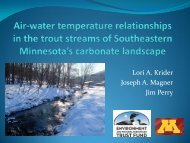Minnesota Water Resources Conference - Water Resources Center ...
Minnesota Water Resources Conference - Water Resources Center ...
Minnesota Water Resources Conference - Water Resources Center ...
Create successful ePaper yourself
Turn your PDF publications into a flip-book with our unique Google optimized e-Paper software.
BOOK OF ABSTRACTS<br />
Tuesday, Monday, October 27 23<br />
Concurrent Sessions III 3:15–4:45<br />
Track C: Hydrologic Impacts of Climate Change<br />
Adapting Stormwater Management to Climate Change<br />
Camilla Correll, Emmons & Olivier <strong>Resources</strong> Inc., ccorrell@eorinc.com; Jennifer Olson, Emmons & Olivier <strong>Resources</strong>, Inc.;<br />
Gary Oberts, Emmons & Olivier <strong>Resources</strong>, Inc.<br />
The certainty of climate warming and changing weather patterns means that standard practices of the past<br />
for stormwater managers must also change. Summers that will be warmer, drier, and stormier, and winters<br />
that will be wetter and stormier both imply a need for adaptive practices beginning immediately, since change<br />
has already begun. An increase in extreme events has been evidenced over the past 20-30 years and threatens<br />
to double in the future. A look at changing weather patterns, hydrologic/hydraulic response, water quality,<br />
surface and ground water levels, model paradigms, and BMP approaches are all necessary if we are to adapt<br />
without major infrastructure disruption. Secondary impacts on water supply and wastewater will also be briefly<br />
mentioned.<br />
Devils Lake: Hydrologic Analysis of a Closed Basin System<br />
Kari Layman, US Army Corps of Engineers, kari.l.layman@usace.army.mil; Rick L. Hauck, U.S. Army Corps of Engineers<br />
The Devils Lake basin is a 3,810 square-mile closed sub-basin of the Red River of the North. There is zero<br />
outflow prior to the lake exceeding the natural overflow elevation of 1459.0 ft. Between July 1993 and July 2005,<br />
precipitation levels within the Devils Lake basin caused the water surface elevation of Devils Lake to increase<br />
from 1422.6 to 1449.3 ft. The 26.7 foot vertical rise resulted in an increase in lake surface area from 53,300 to<br />
136,700 acres.<br />
The rising lake waters impacted the City of Devils Lake flood protection project and the existing transportation<br />
system. A risk based analysis was completed to evaluate the flood protection project for Federal Emergency<br />
Management Agency certification. Given the current conditions, the analysis demonstrated, with reasonable<br />
assurance, that the project will safely contain the one-percent event. In addition, hydrologic dam safety<br />
analyses were completed to determine the appropriate top elevation for transportation routes that now<br />
impound water.<br />
Influence of Climate Change on Flow in the <strong>Minnesota</strong> River at Mankato<br />
Jeramy Kulesa, University of <strong>Minnesota</strong>, kulesa@umn.edu; David Mulla, University of <strong>Minnesota</strong><br />
The effects of increasing precipitation on streamflow have been extensively studied extensively. Results of those<br />
studies indicate that there is a relationship between increasing precipitation and flow, but the correlation is not<br />
always high. Precipitation is just one component of both the changing climate and the hydrologic cycle that<br />
drives flow. Rather than using precipitation as a metric for climate change, the Palmer Drought Severity Index<br />
(PDSI) was used. This index takes precipitation into account, but also temperature and evapotranspiration<br />
to get a better measure of the overall hydrologic effects of climate change. Results showed a strong (p
















